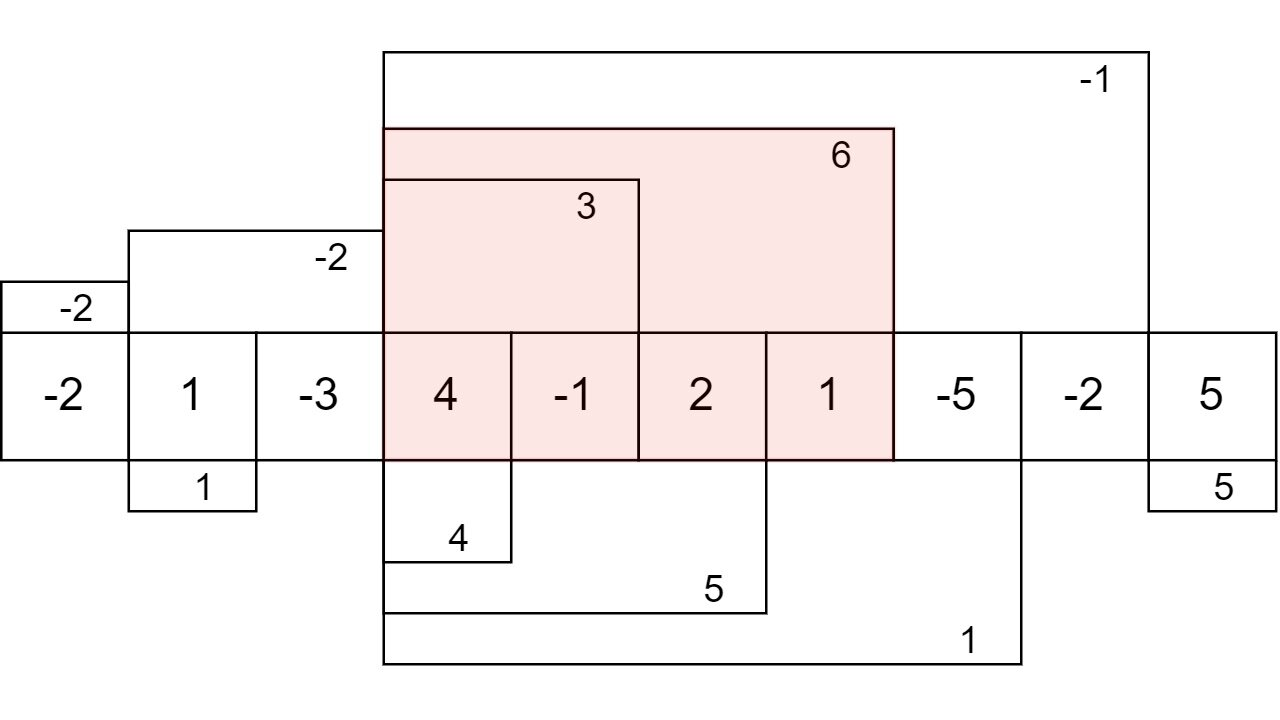友情支持
如果您觉得这个笔记对您有所帮助,看在D瓜哥码这么多字的辛苦上,请友情支持一下,D瓜哥感激不尽,😜
|
|
有些打赏的朋友希望可以加个好友,欢迎关注D 瓜哥的微信公众号,这样就可以通过公众号的回复直接给我发信息。

公众号的微信号是: jikerizhi。因为众所周知的原因,有时图片加载不出来。 如果图片加载不出来可以直接通过搜索微信号来查找我的公众号。 |
53. 最大子数组和
给你一个整数数组 nums,请你找出一个具有最大和的连续子数组(子数组最少包含一个元素),返回其最大和。
子数组是数组中的一个连续部分。
示例 1:
输入:nums = [-2,1,-3,4,-1,2,1,-5,4] 输出:6 解释:连续子数组 [4,-1,2,1] 的和最大,为 6 。
示例 2:
输入:nums = [1] 输出:1
示例 3:
输入:nums = [5,4,-1,7,8] 输出:23
提示:
-
1 <= nums.length <= 105 -
-104 <= nums[i] <= 104
进阶:如果你已经实现复杂度为 \(O(n)\) 的解法,尝试使用更为精妙的 分治法 求解。
思路分析
使用动态规划,在“当前元素”与“当前元素加之前数组的和”之间,取最大值作为动态规划的结果,向前推进。在所有动态结果中,取最大值即可。
\(f(x)\) 表示从 0 到第 x 个元素的最大子数组和,如果第 x-1 个元素的最大子数组之和大于 0,则可以继续向上“盖楼”;当小于等于 0 时,可以抛弃前面的元素从新开始。则递推公式是: \(f(x)=max(f(x-1),0)+a[x]\)。这个做法也叫做 Kadane 算法。

| 另有更精妙的分治解法和前缀和解法,抽空再尝试。 |
-
一刷
-
二刷
-
三刷
-
四刷
-
五刷
1
2
3
4
5
6
7
8
9
10
11
12
13
14
15
16
17
18
19
20
21
22
23
24
25
26
/**
* @author D瓜哥 · https://www.diguage.com
* @since 2019-10-23 11:47
*/
public int maxSubArrayDP(int[] nums) {
// TODO Dynamic Programming
// TODO Divide and Conquer
return 0;
}
/**
* Runtime: 1 ms, faster than 86.91% of Java online submissions for Maximum Subarray.
*
* Memory Usage: 42.1 MB, less than 5.16% of Java online submissions for Maximum Subarray.
*/
public int maxSubArray(int[] nums) {
if (Objects.isNull(nums) || nums.length == 0) {
return 0;
}
int largestSum = nums[0];
int largestEndingHere = nums[0];
for (int i = 1; i < nums.length; i++) {
largestEndingHere = Math.max(largestEndingHere + nums[i], nums[i]);
largestSum = Math.max(largestSum, largestEndingHere);
}
return largestSum;
}
1
2
3
4
5
6
7
8
9
10
11
12
13
14
15
/**
* @author D瓜哥 · https://www.diguage.com
* @since 2025-04-05 11:05:10
*/
public int maxSubArray(int[] nums) {
// 这里还可以优化成一个 int 型变量
int[] dp = new int[nums.length];
dp[0] = nums[0];
int result = dp[0];
for (int i = 1; i < nums.length; i++) {
dp[i] = Math.max(dp[i - 1] + nums[i], nums[i]);
result = Math.max(result, dp[i]);
}
return result;
}
1
2
3
4
5
6
7
8
9
10
11
12
13
14
/**
* @author D瓜哥 · https://www.diguage.com
* @since 2025-10-01 22:49:36
*/
public int maxSubArray(int[] nums) {
int[] dp = new int[nums.length];
dp[0] = nums[0];
int result = nums[0];
for (int i = 1; i < nums.length; i++) {
dp[i] = Math.max(dp[i - 1], 0) + nums[i];
result = Math.max(result, dp[i]);
}
return result;
}
1
2
3
4
5
6
7
8
9
10
11
12
13
14
15
/**
* @author D瓜哥 · https://www.diguage.com
* @since 2025-11-02 11:27:26
*/
public int maxSubArray(int[] nums) {
int[] dp = new int[nums.length];
dp[0] = nums[0];
int result = dp[0];
for (int i = 1; i < nums.length; i++) {
dp[i] = Math.max(dp[i - 1] + nums[i], nums[i]);
// 等价于 dp[i] = Math.max(dp[i - 1], 0) + nums[i];
result = Math.max(result, dp[i]);
}
return result;
}
1
2
3
4
5
6
7
8
9
10
11
12
13
/**
* @author D瓜哥 · https://www.diguage.com
* @since 2025-12-15 20:47:26
*/
public int maxSubArray(int[] nums) {
int result = nums[0];
int curr = 0;
for (int num : nums) {
curr = Math.max(curr + num, num);
result = Math.max(result, curr);
}
return result;
}

